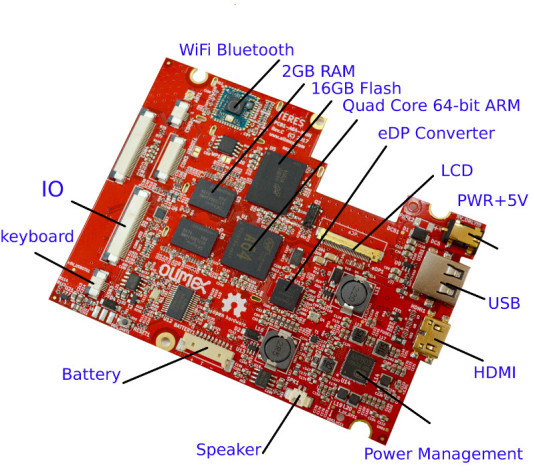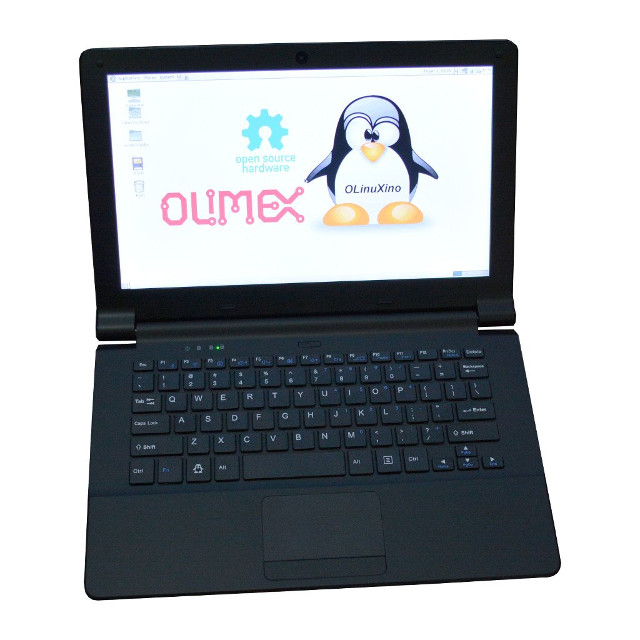Olimex has been working on their open source hardware TERES-I DIY laptop since last year. The laptop is supposed to come in kit form, so that you can build it yourself. Every board and most parts are open source to let your easily repair it, or improve it by adapting the part to your own needs.
The company has now launched the laptop kit for 240 Euros in black or white.
Olimex TERES-I laptop updated specifications:
- SoC – Allwinner A64 quad core ARM Cortex-A53 processor @ 1.2 GHz with Mali-400MP2 GPU
- System Memory – 2GB DDR3L
- Storage – 16 GB eMMC Flash, micro SD slot
- Display – 11.6″ LCD display with 1366×768 resolution
- Video Output – 1x HDMI 1.4 port
- Audio – Via mini HDMI, 3.5mm audio jack, 2x speakers, microphone
- Connectivity – 802.11 b/g/n WiFi up to 150Mbps, Bluetooth 4.0 LE
- USB – 2x USB port ports
- Front camera
- QWERTY keyboard + touchpad with 2 buttons
- Debugging – Serial debug via header or 3.5mm audio jack
- Power Supply – 5V/3A
- Battery – 9,500mAh capacity
- Weight – ~1 kg
The laptop will ship with Ubuntu 16.04 LTS with Mate, Firefox browser, Video player, Open Office, Arduino IDE and IceStorm for FPGA development (an FPGA add-on board is planned).

The build instructions can be downloaded here. Hardware design files for all 5 boards for the laptop, and software will soon be all found on Github. Note that the laptop is intended for engineering development and evaluation only, should not be considered a finished product, and may not comply with FCC, CE or UL directives. Olimex had quite a lot of people registered their interests before, so they only expect to be able to fulfill new order within 2 or 3 weeks.

Jean-Luc started CNX Software in 2010 as a part-time endeavor, before quitting his job as a software engineering manager, and starting to write daily news, and reviews full time later in 2011.
Support CNX Software! Donate via cryptocurrencies, become a Patron on Patreon, or purchase goods on Amazon or Aliexpress






Why the A64 and not the H5? Are the tablet features of the a64 that compelling? I would think that the extra USB ports and such would make the H5 more compelling?
lovely but a tiny bit pricey; are you aware of similar oshw laptop kits ?
Since none of the Allwinner H chips so far comes with PMIC companion and battery support. Speaking about PMIC and battery: I hope Olimex’ tutorial how to assemble the laptop on Github is outdated and will be replaced by a newer version also covering some sort of a heatsink for A64 and AXP803 since both IC can get quite hot (the latter especially when the battery is allowed to charge with high currents)
Damn, I should’ve preordered. Now I’ll have to line up : /
@willmore
@tkaiser
Actually, the most important part is that the A64 supports LCD displays, where’s the H models only have HDMI and analogue video out.
You can get a NanoPi A64 for $19.99 right now while on sale. Just wonder what Friendlyelec could do if they chose to try, in this motherboard market.
@TLS
I don’t believe so but might be wrong. Olimex’ Tsvetan explained last year that the types of slim laptop displays for whatever reasons today all use eDP and that’s why you find in all those A64 laptops today (be it Pinebook, the Azpen Hybrx or the Olimex one here) an ANX6345 chip (RGB to DisplayPort) so dual display operation is possible exposing the SoC’s HDMI port externally. But I would believe HDMI-to-(e)DP chips also exist…
@tkaiser
zidoo h6 board comes with axp805. but if it’s supported by h6 or just frankenbuild, who knows.
@kc
I know, that’s why the ‘so far’ above was in italic wrt Allwinner H SoCs and battery support (since H6 is brand new and wasn’t an option for any of the Allwinner laptops we deal with currently).
IIRC AXP805 lacks battery management capabilities but I might be wrong. We might see soon, there’s Orange Pi 3 Plus and Pine’s H64 board in the pipeline, both with H6. But still the more logical successor to A64 will be A63 (also in 28nm like H6, battery capabilities for sure and eDP instead of HDMI IIRC)
@tkaiser
Thanks, that’s the kind of thing I was looking for. The tablet chips get paired (and have better kernel support one assumes) for more advanced, battery supporting PMICs. That makes sense.
No technical reason you couldn’t pair and H5(H6) with one, but it’s not an Allwinner reference derived design then, right? Which gets into what @kc was saying.
@TLS, yeah, I had originally though that, but then I saw the eDP converter in the diagram and said, “Well, they’re not even using the pannel interface.” Having an external HDMI and more USB sounds like a win.
Well, it’s not just kernel but also u-boot. What happens when you come back home with your laptop being shut down with only less than 10% charged and connect it to mains? It starts up again and with Allwinner’s legacy u-boot enters a state where shortly a battery charging logo is displayed (depending on battery capacity), then A64 sits in u-boot waiting/charging and only once the user presses the power button u-boot hands over to the kernel which then starts the OS. So legacy u-boot contains all the logic to deal with charging this thing (configurable wrt 3 different states) and AFAIK also preventing things catching fire.
I don’t know exactly what will still be working when dropping Allwinner’s BSP stuff. AFAIK more or less in linux-sunxi community only Icenowy is busy with A64 any more and has some patches for PMIC/battery mainline kernel support not landed upstream yet but I’ve not the slightest idea about PMIC/charging support in mainline u-boot (which is AFAIK a requirement for mainline kernel). Though for the target audience of Olimex’ laptop this might not matter (developers should be able to deal with ‘rules’ like ‘Do not connect this laptop when running mainline u-boot/kernel to mains when the lid is closed and it’s in a bag since it will catch fire within 20 minutes’)
@tkaiser
Great summay of the issues, thanks!
@willmore
I might be totally wrong but when starting to play with PineBook and software support half a year ago that was my impression that we currently rely on code from Allwinner (BSP u-boot and kernel + BLOBs) that implements charging control/monitoring in both u-boot and kernel and using the embedded AR100 OpenRISC core that is part of A64, for which we have neither sufficient documentation nor code. I don’t know how things should work with mainline since there’s no AR100 support yet AFAIK (here I might be wrong since I don’t follow closely what happens in boring Allwinner world any more that much).
And I’m only talking about this charging stuff and safety here. General PMIC support in mainline kernel to implement DVFS so A64 can clock higher and reduce energy in idle is related but IMO a different thing. And mainline kernel in general works quite well, IIRC we booted Armbian on A64 in August 2016 already after collecting all the various patches that had not landed upstream back then).
This thing can’t catch on fire, because there is a secondary protection built into the battery cell itself, so even if pmic fails or there are sw bugs, this protection will kick in and cutoff the battery.